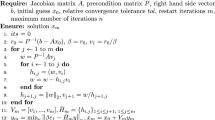Abstract
In this paper, a novel parallel algorithm is proposed to solve the problems of heavy computation and long simulation time in the field of compressible flows. In this algorithm, a third-order upwind scheme and a fourth-order central difference scheme are employed, with a third-order Runge-Kutta method for time stepping. Considering the powerful floating-point computing ability of the Graphics Processing Unit (GPU), this paper establishes the algorithm on the basis of GPU. Moreover, the direct numerical simulation method is adopted in this algorithm to improve the solution accuracy of the simulation results. To further enhance the efficiency of the algorithm, several optimization strategies are explored in the design of the algorithm as well. Both accuracy and feasibility of the algorithm are verified by a classical two-dimensional example. Compared with solving this example on the Central Processing Unit platform, the experimental results demonstrate that the maximum speedup ratio achieved by our approach is 18.03 times.








Similar content being viewed by others
References
Li Y, Reimann B, Eggers T (2016) Coupled simulation of CFD-flight-mechanics with a two-species-gas-model for the hot rocket staging. Acta Astronaut 128:44–61. https://doi.org/10.1016/j.actaastro.2016.07.009
Sun XW, Liu W, Chai ZX (2019) Method investigation for numerical simulation on aero-optical effect based on WCNS-E-5. AIAA J 57(5):2017–2029. https://doi.org/10.2514/1.j057961
Cook AW, Riley JJ (1996) Direct numerical simulation of a turbulent reactive plume on a parallel computer. J Comput Phys 129(2):263–283. https://doi.org/10.1006/jcph.1996.0249
Jimenez J (2003) Computing high-reynolds-number turbulence: will simulations ever replace experiments. J Turbul 4(22):1–14. https://doi.org/10.1088/1468-5248/4/1/022
Mostafazadeh DB, Marti F, Pourghassemi B, Liu F, Chandramowlishwaran A (2017) Unsteady navier-stokes computations on GPU architectures. In: 23rd AIAA Computational Fluid Dynamics Conference, p 4508. https://doi.org/https://doi.org/10.2514/6.2017-4508
Nguyen MT, Castonguay P, Laurendeau E (2019) GPU parallelization of multigrid RANS solver for three-dimensional aerodynamic simulations on multiblock grids. J Supercomput 75(1):2562–2583. https://doi.org/10.1007/s11227-018-2653-6
Vermeire BC, Witherden FD, Vincent PE (2017) On the utility of GPU accelerated high-order methods for unsteady flow simulations: a comparison with industry-standard tools. J Comput Phys 334:497–521. https://doi.org/10.1016/j.jcp.2016.12.049
Thibault JC, Senocak I (2012) Accelerating incompressible flow computations with a pthreads-CUDA implementation on small-footprint multi–GPU platforms. J Supercomput 59(1):693–719. https://doi.org/10.1007/s11227-010-0468-1
NVIDIA (2019) CUDA C programming guide. https://docs.nvidia.com/cuda/cuda-c-programming-guide/index.html#axzz4atgDRVPb. Accessed 11 May 2019
Corrigan A, Camelli FF, Lohner R et al (2011) Running unstructured grid-based CFD solvers on modern graphics hardware. Int J Numer Methods Fluids 66(2):221–229. https://doi.org/10.2514/6.2009-4001
Niksiar P, Ashrafizadeh A, Shams M et al (2014) Implementation of a GPU-based CFD code. In: 2014 International Conference on Computational Science and Computational Intelligence, pp 84–89
Williams J, Sarofeen C, Shan H et al (2016) An accelerated iterative linear solver with GPUs for CFD calculations of unstructured grids. Procedia Comput Sci 80:1291–1300. https://doi.org/10.1016/j.procs.2016.05.504
Hashimoto T, Yasuda T, Tanno I et al (2018) Multi-GPU parallel computation of unsteady incompressible flows using kinetically reduced local Navier-Stokes equations. Comput Fluids 167:215–220. https://doi.org/10.1016/j.compfluid.2018.03.028
Zhang JL, Chen HQ, Xu SG, Gao HQ (2020) A novel GPU-parallelized meshless method for solving compressible turbulent flows. Comput Math Appl 80:2738–2763. https://doi.org/10.1016/j.camwa.2020.08.030
Romero J, Crabill J, Watkins JD, Witherden FD, Jameson A (2020) ZEFR: a GPU-accelerated high-order solver for compressible viscous flows using the flux reconstruction method. Comput Phys Commun 250:107–169. https://doi.org/10.1016/j.cpc.2020.107169
Blazek J (2015) Computational fluid dynamics: principles and applications. Elsevier, Amsterdam
Anderson JD (1984) Fundamentals of aerodynamics. McGraw-Hill, New York
Steger JL, Warming RF (1981) Flux vector splitting of the inviscid gasdynamic equations with application to finite-difference methods. J Comput Phys 40(2):263–293. https://doi.org/10.1016/0021-9991(81)90210-2
Jameson A, Schmidt W, Turkel E (1981) Numerical solution of the euler equations by finite volume methods using Runge Kutta time stepping schemes. In: T2–14th Fluid and Plasma Dynamics Conference T3-Fluid Dynamics and Co-located Conferences. https://doi.org/https://doi.org/10.2514/6.1981-1259
Balaji P, Buntinas D, Goodell D et al (2011) MPI on millions of cores. Parallel Process Lett 21(01):45–60. https://doi.org/10.1142/S0129626411000060
Mininni PD, Rosenberg D, Reddy R et al (2011) A hybrid MPI-OpenMP scheme for scalable parallel pseudospectral computations for fluid turbulence. Parallel Comput 37(6):316–326. https://doi.org/10.1016/j.parco.2011.05.004
NVIDIA (2018) GeForce GTX 10 series graphics cards. https://www.nvidia.com/en-us/geforce/10-series/. Accessed 17 Nov 2018
Shane C (2012) CUDA programming: a developer’s guide to parallel computing with GPUs. Elsevier, Amsterdam
Norouzi HR, Zarghami R, Mostoufi N (2017) New hybrid CPU–GPU solver for CFD–DEM simulation of fluidized beds. Powder Technol 316:233–244. https://doi.org/10.1016/j.powtec.2016.11.061
Ryoo S, Rodrigues C, Baghsorkhi S et al (2008) Optimization principles and application performance evaluation of a multithreaded GPU using CUDA. In: Proceedings of the 13th ACM SIGPLAN Symposium on Principles and Practice of Parallel Programming, pp 73–82. https://doi.org/https://doi.org/10.1145/1345206.1345220
Leskinen J, Periaux J (2013) Distributed evolutionary optimization using Nash games and GPUs-applications to CFD design problems. Comput Fluids 80:190–201. https://doi.org/10.1016/j.compfluid.2012.03.017
Lefebvre M, Guillen P, Le Gouez JM, Basdevant C (2012) Optimizing 2D and 3D structured Euler CFD solvers on graphical processing units. Comput Fluids 70:136–147. https://doi.org/10.1016/j.compfluid.2012.09.013
NVIDIA (2012) How to optimize data transfers in CUDA C/C++. https://devblogs.nvidia.com/how-optimize-data-transfers-cuda-cc. Accessed 29 May 2019
Daniels PG (1974) Numerical and asymptotic solutions for the supersonic flow near the trailing edge of a flat plate. Q J Mech Appl Math 27(2):175–191. https://doi.org/10.1093/qjmam/27.2.175
Weyl H (1942) On the differential equations of the simplest boundary-layer problems. Ann Math 43(2):381–407. https://doi.org/10.2307/1968875
Acknowledgements
This work is supported by the National Natural Science Foundation of China under Grand No. 51705390, the Pre-Research Program under Grant No. 61400010111, and the Natural Science Foundation of Shaanxi Province under Grand No. 2018JQ5029.
Author information
Authors and Affiliations
Corresponding author
Additional information
Publisher's Note
Springer Nature remains neutral with regard to jurisdictional claims in published maps and institutional affiliations.
Rights and permissions
About this article
Cite this article
Wang, Y., Yan, X. & Zhang, J. Research on GPU parallel algorithm for direct numerical solution of two-dimensional compressible flows. J Supercomput 77, 10921–10941 (2021). https://doi.org/10.1007/s11227-021-03704-9
Accepted:
Published:
Issue Date:
DOI: https://doi.org/10.1007/s11227-021-03704-9




